Amar Gopal Bose, The Audiophile Ahead of His Time.
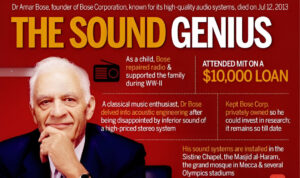
When you think of the world’s best audio system, the name that comes to your mind is Bose Speakers, designed and invented by Dr. Amar Gopal Bose, who also introduced the world’s first commercial noise-canceling audio phones, and design bespoke audio systems for the cars. Its quality after their intensive research made the name Bose synonymous with best quality audio systems for space shuttle astronauts and airlines pilots, auditoriums, sports stadiums, defense services, business complex, home users and automobiles. The system also made its place at Staples Center in Los Angeles, the Sistine Chapel and the Masjid al-Haram, the grand mosque in Mecca.
Fulbright alumnus Amar Bose combined his interest in music and electronics to establish the Bose Corporation after undertaking his Fulbright research in the 1950s. The iconic brand Bose is an example of inventions possible when American ingenuity combines with opportunities for in-depth study and cutting-edge research through the Fulbright Program. Even after Bose’s death in 2013, the company he founded continues his legacy of engineering excellence and is guided by its founder’s vision: “Never lose your imagination. Always dream of things that are better and think about ways to reach those things.”
Amar Gopal Bose was born at Philadelphia (November 2, 1929 – July 12, 2013). His father, Noni Gopal Bose, was a freedom fighter while studying physics at Calcutta University, He was imprisoned during British rule in India. He escaped and fled to the United States in 1920, where he finally settled.
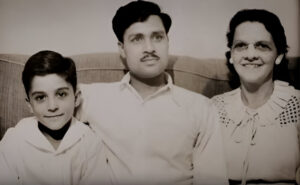
So, Amar grew up in Philadelphia and attended Abington Senior High School. During his childhood, he displayed his keen interest with home-based venture for repair and manufacture electronics. His efforts impressed his father, who saved what he could and borrowed the rest in order to ensure that his son receives a thorough education. By 13, the child was fixing radios in his parents’ basement and earned regular pocket money. The hobby became a business and helped support the family when his Indian-immigrant father’s import business was shut down by a shipping ban during World War II.
He was an amateur violinist. During the 1950’s he developed an interest in improving audio quality after experiencing all the disappointing noise from speakers.
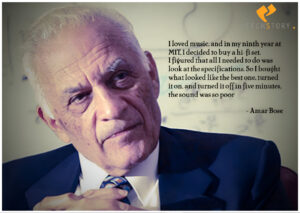
Subsequently, Bose enrolled with Massachusetts Institute of Technology for Bachelor’s degree in Electrical Engineering, and then Master’s degree and then a Doctorate, all from MIT. After graduation, he was offered a job as an Assistant Professor at MIT, something he had never considered doing before. However, he accepted and held the post of Professor for 45 years. He was the second South Asian American student to attend MIT and the very first South Asian to be appointed to the faculty of MIT.
While submitting his doctoral thesis in 1956 he came up with the idea of direct and reflecting sounds. He spent a year in Netherlands working in the research labs at NV Philips Electronics and another year as a researcher in India, sponsored by the Fulbright scholarship, at the National Physical Laboratory in New Delhi. When Bose completed his doctorate, he rewarded himself with a new Hi-Fi sound system. His disappointment in the sound quality led him to ask a fateful question—was there a better way to replicate concert hall quality of sound through a speaker?
He founded the Bose Corporation in 1964. Its first contracts supplied the U.S. Military and NASA with products that improved audio communications.
He reached investors, including his former MIT thesis advisor, Dr. Y. W. Lee for the funds. In the ‘60s, it introduced the world’s first commercial noise-canceling headphones, and it became the first company to design bespoke audio systems for cars. Subsequently he held over two dozen patents in audio technology.
But the speakers didn’t produce perfect audio. All the time he had to spend carefully comparing specifications had still left him with disappointments. So, his team began further researching on acoustics during daytime working on their government contracts, and then again at nights researching acoustics. The first product they made, the 2201, was shaped like an eighth of a sphere so it could be tucked into the exact corner of a room. Its 22 transducers projected sounds in various directions, bouncing them off the walls and floor of a room. But it was a failure.
The company was trying to develop products — but with high price tags. It was a major commercial failure. The company had spent a sizable amount of its government contract funds to hire a marketing consultant, who said Bose would sell about $2 million worth of 2201 speaker pairs in the first year. They could actually sale only about 30 pairs.
Learning from the failure, Bose engineers kept researching until they came up with the 901. They built a small computer Bose 1001 that was hooked with a 901 speaker, the Bose 1001 computer staged a 7½-minute demonstration of the speaker’s sound. Then Bose convinced audio dealers to pony up $1,000 each for one of these computers. Bose himself demonstrated the speakers to influential journalists in the small world of high-fidelity audio magazines. After that, sales took off. After more than a decade of hard work, the first noise-canceling audio phones sold worth $50 million and. The technology led to the successful Quiet Comfort line of consumer demands. And in 1982 Mercedes and Porsche offered Bose audio systems in their cars. In 1983 Cadillac Seville did the same, and the brand became the most favorite in consumer market. The Cadillac CT6 model offers 34 speakers.
By refusing to offer his company stock to the public, Dr. Bose was able to pursue long-term research, without the pressures of quarterly earnings announcements.
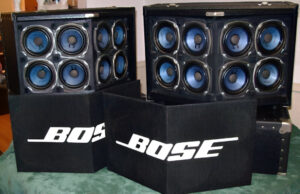
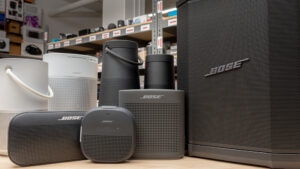
In a 2004 interview in Popular Science magazine, he said:
“I would have been fired a hundred times at a company run by M.B.A.’s. But I never went into business to make money. I went into business so that I could do interesting things that hadn’t been done before”.
Bose said,
“If I tell you that ‘better’ inspires fear — that even in the corporate world, people are scared of something better, you’d say that’s ridiculous; everybody wants something better. Well, something better is always different. It isn’t possible to make something better that isn’t different. Whatever it is, if it’s exactly the same, it isn’t better. So it’s the ‘different’ that scares people. When something’s different, it’s a heck of a gamble. And that’s where ‘courage’ comes in.”
In 2011, he donated a majority of the company profit to MIT in the form of non-voting shares to sustain and advance MIT’s education and research mission.
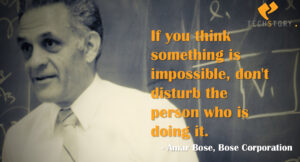
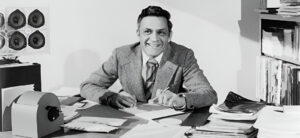
Honors:
• Inducted into the National Inventors Hall of Fame in 2008.
• In 2011, he was listed at no. 9 on the MIT150 list of the top 150 innovators and ideas from MIT.
• Fellow, IEEE, 1972 – for contributions to loudspeaker design, two-state amplifier-modulators, and nonlinear systems.
• Honorary member, Audio Engineering Society, 1985.
• The 2010 IEEE/RSE Wolfson James Clerk Maxwell Award, for “outstanding contributions to consumer electronics in sound reproduction, industrial leadership, and engineering education”.
• Beryllium Lifetime Achievement Award, Association of Loudspeaker Manufacturing & Acoustics International, 2014.
• Founders Award at the Asian Awards 2015.
(Source: CNBC, Forbes, Famous Inventors, Wikipedia).
* https://www.forbes.com/profile/amar-bose/
* http://www.famousinventors.org/amar-bose
* https://timeline.bose.com/decade/early-life
* https://www.fulbrightprogram.org/amar-bose/
* https://www.cnbc.com/
* http://www.nytimes.com/2013/07/13/business/
*********




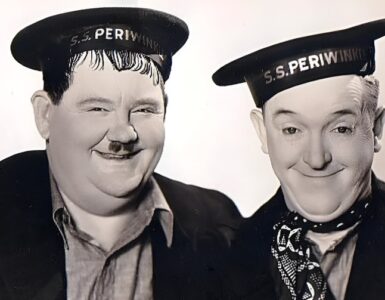









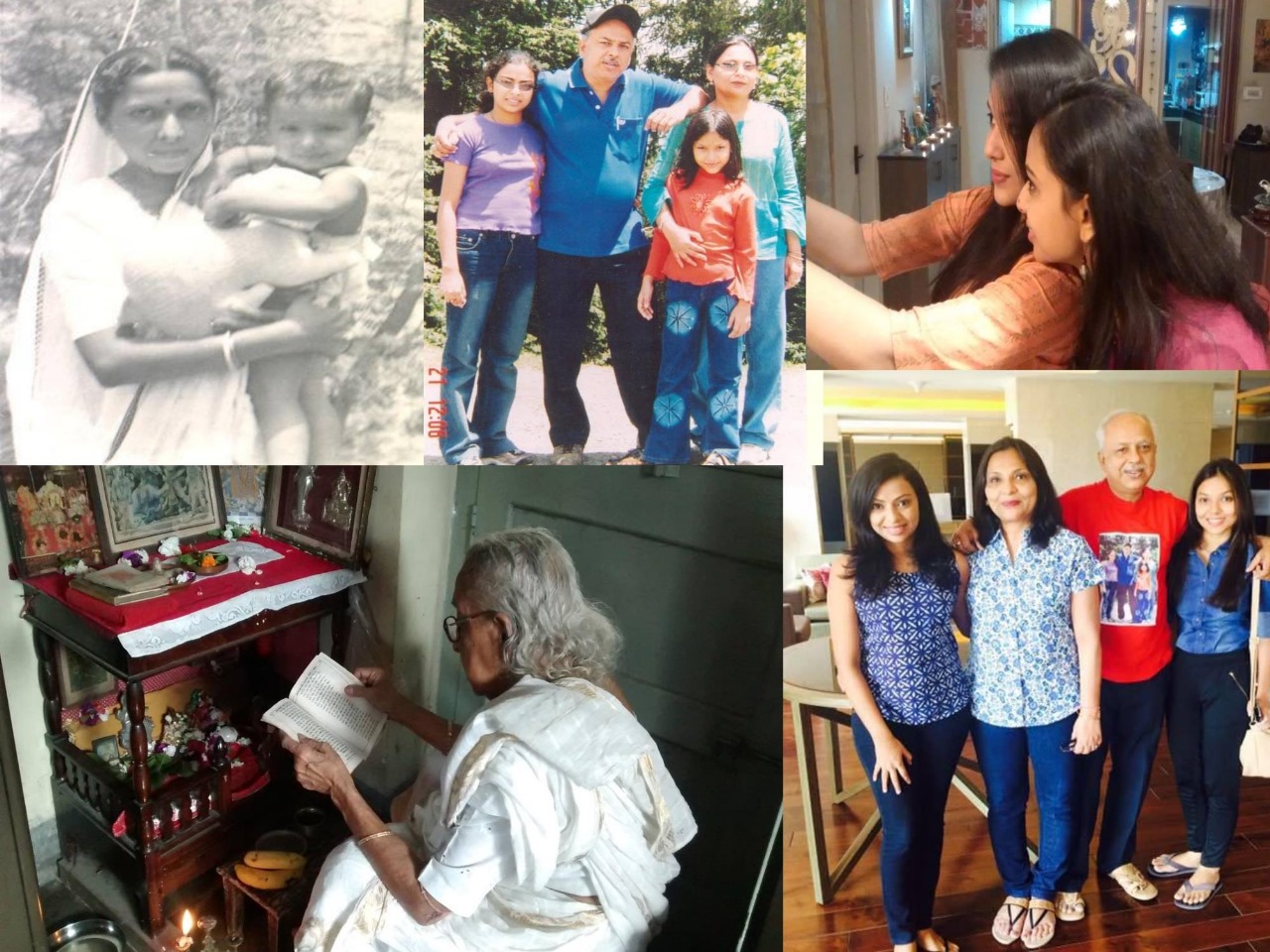
Add comment